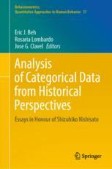Search
Search Results
-
Multivariate Abundances—Inference About Environmental Associations
The most common type of multivariate data collected in ecology is also one of the most challenging types to analyse—when some abundance-related...
-
Boosted-oriented probabilistic smoothing-spline clustering of series
Fuzzy clustering methods allow the objects to belong to several clusters simultaneously, with different degrees of membership. However, a factor that...

-
Log-Linear and Log-Multiplicative Association Models for Categorical Data
The chapter reviews uni- and multidimensional association models (AMs) that provide a parsimonious modelling of interactions between categorical...
-
Modeling Asymmetric Exchanges Between Clusters
A nonhierarchical clustering model is proposed here which jointly fits the symmetric and skew-symmetric components of an asymmetric pairwise...
-
Spatial quantile clustering of climate data
In the era of climate change, the distribution of climate variables evolves with changes not limited to the mean value. Consequently, clustering...

-
Batch Self-Organizing Maps for Distributional Data with an Automatic Weighting of Variables and Components
This paper deals with a batch self organizing map algorithm for data described by distributional-valued variables (DBSOM). Such variables are...

-
Spatial and Spatiotemporal Patterns
Spatial and spatiotemporal Spatiotemporal dynamics data analysis is of great importance in disease dynamics for a number of reasons such as looking...
-
Analysis of Contingency Table by Two-Mode Two-Way Multidimensional Scaling with Bayesian Estimation
Visualisation methods for contingency tables, such as correspondence analysis and dual scaling, are widely used in many research fields. These...
-
Totally Balanced Dissimilarities
We show in this paper a bijection between totally balanced hypergraphs and so-called totally balanced dissimilarities. We give an efficient way ( O ( n 3 )...

-
Dimensionality Reduction
In many cases data analytics has to cope with the extremely high dimension of the input. Structures may be well hidden not only by the sheer amount...
-
Gene Coexpression Analysis with Dirichlet Mixture Model: Accelerating Model Evaluation Through Closed-Form KL Divergence Approximation Using Variational Techniques
Gene coexpression analysis poses unique challenges, particularly in clustering normalized gene profiles where dedicated algorithms are lacking....
-
Cluster Analysis for Asymmetry
Models and methods of cluster analysis for asymmetric data are presented by considering two main classes: hierarchical and non-hierarchical methods....
-
Unsupervised Learning
Most of this book concerns supervised learning methods such as regression and classification. In the supervised learning setting, we typically have...
-
A Novel Classification Algorithm Based on the Synergy Between Dynamic Clustering with Adaptive Distances and K-Nearest Neighbors
This paper introduces a novel supervised classification method based on dynamic clustering (DC) and K-nearest neighbor (KNN) learning algorithms,...

-
Clustering
The goal of this chapter is to survey and present the main concepts and techniques from the vast collection of clustering models, from the...
-
The δ-Machine: Classification Based on Distances Towards Prototypes
We introduce the δ -machine, a statistical learning tool for classification based on (dis)similarities between profiles of the observations to...

-
Introduction
In many disciplines such as psychology, sociology, marketing research, behavioural sciences, and so on, systems of relationships between pairs of...
-
Classification of Events Using Local Pair Correlation Functions for Spatial Point Patterns
Spatial point pattern analysis usually concerns identifying features in an observation window where there is also noise. This identification...

-
A Comparison of Different Clustering Approaches for High-Dimensional Presence-Absence Data
Presence-absence data is defined by vectors or matrices of zeroes and ones, where the ones usually indicate a “presence” in a certain place....
